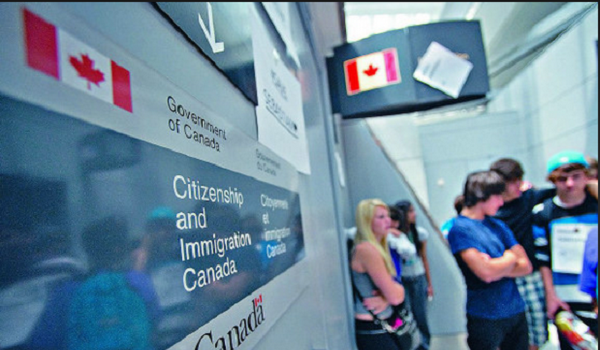Canada’s immigration contributes immensely to economic growth and there are ways to tap from it
Lately the word “immigrant” is associated with a cost-of-living crisis, a housing shortage, and added pressure on already overstressed health-care and education systems.
But there is another big story here.
The record pace of immigration is strengthening the economy.
Even before the surge, in Ontario and B.C. immigrants accounted for about 40 per cent of entrepreneurs, the people who launch the small businesses that employ the largest share of Canada’s workforce.
And economists have already reported that in Canada and the U.S. — among the few advanced economies not suffering a decline in population growth rates — strong immigration flows have helped keep both countries out of recession.
Precise numbers on this boom aren’t yet available but estimates of the beneficial impact of immigration are staggering.
In a February report, the U.S. Congressional Budget Office (CBO), a venerable bipartisan data bank, calculated that the U.S. increase in immigration could generate additional GDP growth of $9.6 trillion by 2033.
New arrivals fill labour shortages, increasing the size of the paid workforce and with it the level of income-tax receipts.
The CBO estimates that immigration will lift government revenues by about $1.4 trillion in that period.
That will pay for a lot of schools and hospitals.
Immigrants also boost consumer demand.
Ottawa’s targets of 485,000 new permanent residents this year and 500,000 in each of 2025 and 2026 are about double the level as recently as 2020.
So, in the short space of time between 2021 and 2026, Canada will welcome 2.4 million additional residents, a population of new arrivals roughly the size of Atlantic Canada.
Obviously, not all recent immigrants will be big-spending consumers. But a 2021 Canadian census report found that 51.5 per cent of immigrants have earned a bachelor’s degree or higher, about twice the level of non-immigrants.
Now prominent in the growth strategies of Canada’s consumer-oriented companies is a bid to gain as large a share of newly arrived consumers as possible.
You might have noticed this at your automated teller machine with its special offers for new Canadians. Marketing tailored to immigrants is now common at grocers, furniture retailers, telecoms and airlines.
The positive impact is already evident, with another one million immigrants yet to arrive in the next two years.
The slow-growth telecom industry, for example, expects revenue growth of four per cent to 4.5 per cent this year.
Tony Staffieri, CEO of Rogers Communications, has said of that “extremely strong growth” that “half relates to the ‘new-to-Canada’ category.”
Air Canada fairly revels in an immigration surge that is creating additional business in “delivering travel to these new entrants, for business, for pleasure, for going back home, visiting family and friends,” John Di Bert, Air Canada’s chief financial officer, told an investor conference last month.
There are caveats to this economic stimulus.
Many recently arrived Canadians initially spend on essentials and not on big-ticket items like new cars or high-end appliances.
And for many immigrants, the first call on their income after food and rent is remittances to families in their home countries.
In coming years, total remittances can be expected to exceed the 2019 peak of $11.5 billion.
That cuts into disposable income.
But of necessity, newcomers are spending on essentials like food, cooking supplies, beds and other furniture, apparel, mobile phones, transportation services, over-the-counter medications, lower-end sporting goods, school supplies and a great deal more.
Investors can participate in this boom, which will play out over the rest of the decade, with a “New Canadians Portfolio” of big-cap consumer stocks.
The following stocks are listed with their ticker symbols and current share prices.
Food and affordable out-of-home dining:
Loblaw Cos. (L-TO), $161. Sobeys parent Empire Co. (EMP.A-TO), $32. Metro Inc. (MRU-TO), $72. Restaurant Brands International (QSR-TO), owner of Tim Hortons, Burger King, Popeyes, $96.
General merchants:
Dollarama (DOL-T), $129. Canadian Tire (CTC.A-TO), $140. Sleep Country Canada (ZZZ-TO), $26. Leon’s Furniture (LNF-TO), $22.
Utilities:
BCE (BCE-TO), $47. Rogers Communications (RCI.B-TO), $55. Telus Corp. (T-TO), $22. Enbridge (ENB-TO), $49. Fortis (FTS-TO), $55. Hydro One (H-TO), $40.
Housing:
InterRent Real Estate Investment Trust (IIP.UT-TO), $12. Canadian Apartment Properties REIT (CAR.UN-TO), $45. Boardwalk REIT (BEI.UT-TO), $70.
The current economic slowdown, caused largely by high interest rates that finally began to decline this week, sees many of these stocks trading below their most recent peak prices.
That makes them attractive to value investors even without a surge of New Canadian business.
For instance, shares in Canadian Tire and BCE are each trading at a one-third discount to their peak prices.
Another way to invest in newcomers and other Canadians coping with the cost-of-living crisis is to donate food and clothing at your local food bank. You can also donate at most grocery stores.
By investing both in the country’s major employers and directly in people, you can do well by doing good.
This article was first reported by The Star












